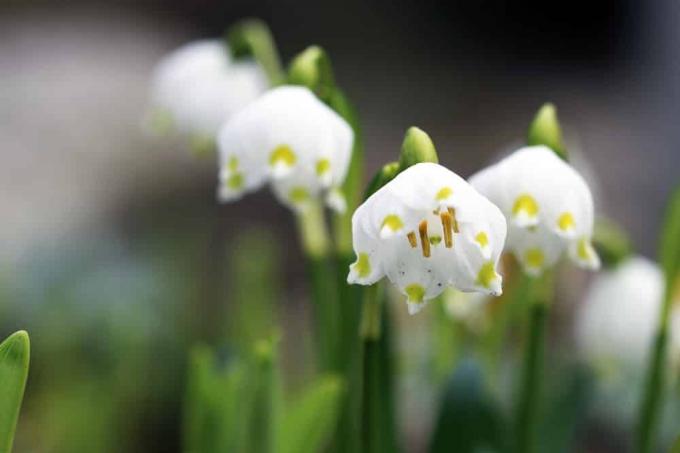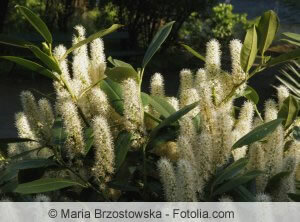

Table of contents
- Which varieties are suitable?
- harvest roses
- Process cut flowers faster
- Harvest edelweiss
- Various drying methods
- air drying
- Pressing between book pages
- Dry salt, detergent and silica gel
- Drying in the oven
- Drying in the microwave
- Drying whole bouquets
- durability
A fresh rose blossom is a special gift. It impresses with its noble shape and the bright clear color. As an encore, there is an intoxicating scent. Unfortunately, it also has a disadvantage: it withers away far too quickly before our eyes. But sometimes we want to keep them forever. Drying prolongs their existence, albeit in a different way.
Which varieties are suitable?
Edelweiss blossoms are ideally suited for drying. This also applies to roses, regardless of whether only rose petals or entire bouquets are to be dried. All varieties from the huge rose family are suitable for this type of preservation. However, the flowers used should be fresh, intensely colored and, if possible, fragrant.
harvest roses
Various types of roses are available in flower shops all year round. If you have rose bushes in your garden, you can use them to your heart's content. However, there are time limits here. In our latitudes, the flowering time of this royal plant is limited to a few months a year due to the prevailing climate.
- Flowering time varies by rose variety
- the first flowers appear as early as May
- Flowering season ends in late autumn
Blooming roses in the garden are an ornament that should be preserved for as long as possible. Nevertheless, the time for the harvest must not be missed.
- Harvest roses before they wilt
- do not use fallen leaves
- Petals should still be attached to the plant
- Don't pluck budding roses apart
Tip:
A flower that has been in the blooming phase for about three days is ideal for drying.
Process cut flowers faster
Roses in bouquets will wither faster than rose petals that are still on the plant. That's why fresh roses should not be admired in the vase for more than two days, then it's time for the drying process. Most of the flowers are still somewhat closed at the beginning. Once they open, they need to be dried. Depending on your wishes with a stem, individual flower heads or just the leaves.
Harvest edelweiss

Edelweiss has found a permanent home in mountainous areas. If you meet him while hiking, you are welcome to admire and photograph him. But don't pick! Because the edelweiss is under nature protection. Flowers for drying can only be provided by specimens that have been cultivated or grown in our own garden. can be bought at the garden center.
- bright white flowers must be avoided
- cultivated varieties are slightly greyish in color
- the abundance of flowers is also more modest in the garden
- the flowers have developed in July
- it can be harvested
Various drying methods
Whether rose or edelweiss, this plays a rather subordinate role for the drying process itself. Depending on how many flowers are to be dried and what the desired result should look like, there are several options available:
- air drying
- Pressing between book pages
- Drying with dry salt, detergent or silica gel
- Drying in the oven
- Drying in the microwave
air drying

Air drying is an easy way to remove moisture from fresh roses and edelweiss without changing their shape significantly. The individual steps are described in more detail below:
- Spread edelweiss, whole rose heads or rose petals on absorbent kitchen paper or on a grid. The flowers or Sheets should not touch or even overlap.
- Set the whole thing to dry in a place that offers plenty of heat. A boiler room is ideal.
- If you use kitchen paper as a base, replace it about every three days. Or change the position of the flowers to places that are still absorbent.
- Turn flowers and leaves regularly so they can dry evenly on both sides.
- Gently shake out dried flowers. Sometimes small crawling animals are still hidden in it, which now fall out when shaken and run away.
Tip:
If the leaves are still soft, there is still residual moisture in them. Allow these leaves to dry a little longer, otherwise mold can form.
Pressing between book pages
The pressing of individual blossoms has a long tradition. A flower is placed between the book pages and the book is closed. The flower gradually loses moisture, but also its natural shape. To ensure that the pressing is even better, the following instructions should be observed.
- Don't put the flower directly on the book pages
- cover with blotting paper or kitchen paper
- the moisture is absorbed better this way
- the sheet sides do not get dirty
- the flower must be positioned well
- Sheets must not be on top of each other
- change the sodden kitchen paper from time to time
Flowers and leaves dried in this way are perfectly flat. They are well suited to decorate letters and pictures.
A notice:
This method is not suitable for large rose heads. Plucked rose petals can be dried well in the book. Due to their shape, edelweiss blossoms are also well suited for this pressing variant.
Dry salt, detergent and silica gel
Dry salt, dry detergent and silica gel have the common property of absorbing moisture. These funds also offer some advantages:
- Drying is faster
- the original flower shape is preserved
- cause better durability
- Dry salt and silica gel can be used repeatedly

How to dry your roses or edelweiss flowers with one of these means:
- Choose a sufficiently large and screwable glass.
- Cover the floor with dry salt, dry detergent or silica gel.
- Put the flowers on top.
- Fill the glass with dry salt and co. If you dry several flowers in it at the same time, make sure that they do not touch each other.
- Seal the jar and leave it like that for about four days.
- Dry salt absorbs the color of the rose. When the salt and blossom have matched in tone, the drying process is complete. With the edelweiss, the effect is not so clearly visible due to the simple greyish colouring.
Tip:
Detergent is cheap and available in every household. For single flowers it is the ideal remedy. Silica gel, on the other hand, is more expensive but can also be used several times. If you are drying buds repeatedly, silica gel is recommended.
Drying in the oven
Drying rose petals in the oven is quick and inexpensive. And this is how it works:
- Put a layer of sand on the baking sheet.
- Distribute the flowers or Leaves. There should be enough space in between.
- Preheat the oven to 40 degrees Celsius.
- Place the baking sheet with the flowers in the oven for about 30 minutes.
- Check if the buds are completely dry. If not, extend your oven time by a few minutes.
Gentle drying in the oven is not only easy to use, the result is also impressive. The dried petals have a decorative curvature and still smell almost like freshly picked.
Drying in the microwave

The quickest way to dry is with a microwave. Since it is now in almost every household, there are hardly any costs associated with this type of drying. What you need for this:
- fresh roses or edelweiss blossoms
- a microwave
- absorbent kitchen paper
- two microwaveable plates
And this is how drying in the microwave works:
- Cover a plate with kitchen paper.
- Distribute the flowers on it with sufficient distance between them.
- Place another layer of kitchen paper on top of the flowers.
- Cover with the second plate.
- Turn on the microwave. With a high wattage, about 40 seconds are sufficient. With a lower wattage, the microwave needs approx. 90 seconds.
- Take out the dried flowers.
Drying whole bouquets

Beautiful bouquets of roses can be dried whole. The roses should be fresh and the blossoms only slightly open.
- Cut all stems at an angle with a sharp knife.
- Place the bouquet in a vase with a mixture of equal parts water and glycerin.
- After two days, remove the bouquet of roses from the vase.
- Divide large bouquets into several small bundles so that drying works well and evenly.
- Hang the bouquet in an airy, cool and dry place. No direct sunlight.
- Depending on the variety of roses and the size of the flowers, the bouquet will remain in the hanging position for about 4-6 days.
- After that you can put the bouquet in a vase without water. They continue to dry in this for about three weeks.
Tip:
You can get glycerine in any pharmacy without a prescription.
durability
While dry roses have a long shelf life, an extension of time is welcome. Spray the dried flowers evenly with a hairspray or hairspray. The annoying smell of the spray disappears quickly and the natural rose scent reappears. Gloss varnish passes its shine on to the flowers. Repeat this procedure every few months. This will keep the beauty of the dried roses or edelweiss flowers for many years.
 garden editorial
garden editorial I write about everything that interests me in my garden.
Learn more about spring gardening tips

Is the cowslip poisonous? Information for people & animals
The cowslip is one of the first flowering plants in spring, which is also often brought into the house. There is conflicting information about the toxicity of cowslips. While many native species are of little concern, there is a considerable danger lurking, especially with exotic indoor primroses.

Clean pool in spring | 5 tips for pool cleaning & commissioning
As soon as it gets warmer outside again in spring, it's time to prepare the pool in the garden for use. This usually means: First of all, it has to be thoroughly cleaned. Here are helpful tips for cleaning and commissioning.

Preparing the vegetable bed: 7 tips for soil in the garden bed | Garden
Preparing the vegetable beds and soil is extremely important for a successful harvest. This step should be done before sowing in spring. The first measures are already necessary at the end of winter so that the soil is sufficiently prepared.

18 spring flowers sorted by color: list with names
Spring brings more light and warmth and the most beautiful flowers sprout. Nature satisfies our longing for colour. When the sky is gray again outside, a glance at the colorful spring flowers is enough to put you in a good mood.

Types of flowers from A-Z: the encyclopedia with 50 types of flowers
Flowers adorn gardens and balconies with their diverse flower shapes and their impressive blaze of colour. The lexicon of the 50 types of flowers tells you which flowers are suitable for the shade and which need a lot of sun in order to bloom colorfully and plentifully. You will also find flowers for every season here.

Creating flowering hedges - planting plan for flowering hedges
A flowering hedge must be well prepared, because not only the choice of variety is decisive, but also where the plants are positioned. This is recorded in advance in a planting plan, where not only the location, but also the The size that the individual perennials take is listed, which will allow them to develop well later can.
